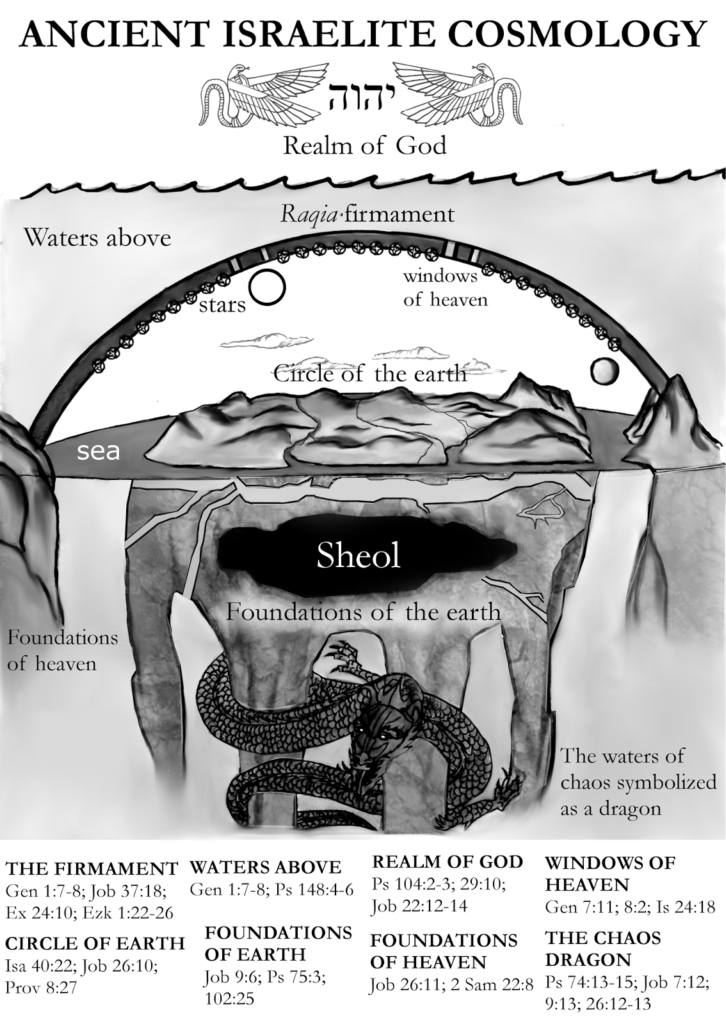
When we read of the creation in Genesis what are our thoughts? Is it factually correct or a metaphorical story? This week’s Bible Study has allowed us to explore this conundrum. What’s the story?
When we look at the timeline for each of the Old Testament or Hebrew Scriptures books we may desire to start with Genesis – that is what it means, the start, the origin, in the beginning (or in Hebrew: Bereshit); however, in terms of its writing we may wish to consider more. If we look at the way that the document is written, the use of specific words, together with the documentary evidence when these fragments were found, we might conclude that the timeline is altered a bit.
1800 BCE
From Babylonian Sumerian myths we have a story that first there was Apsu who was linked to fresh water and there was Tiamat, who was akin to salty bitter water. Apsu, her children Ea and Enki including Marduk, were to eventually kill Tiamat with an arrow that split Tiamat into two: thus forming the Tigris and Euphrates rivers. From the corpse of Tiamat, Marduk created the Heavens and the Earth. Marduk then consulted with Ea, and then created humans togo to war. Ea creates Lullu, the first man, as a helper to the gods. What’s the story?
It’s not the Biblical creation story but there are similarities, I hope you’ll agree. There are greater similarities with the Babylonian Gilgamesh, and Noah and the Flood story as well. Note the year that scholars believe that this was written. That’s some time ago.

Fast forward to:
600-500 BCE
The Jews had had a tough time in Babylon and so Chapter 1 up to Chapter 2:3 of Genesis – the first creation story – was believed to have been written to explain the construction of the Cosmos as God’s house aka Temple. Note Persians had conquered Babylon in 538 BCE granting Jerusalem autonomous rule. The battle for monotheism and polytheism was now in full swing.
The Cosmos contained the heavens, the flat earth and the underworld or Sheol, all surrounded by the ocean of chaos. Oceans have been a big aspect of creation. Note the Babylonian myth included chaotic water, as do many instances of beats coming from the deep (Psalm 74 and Isaiah 51).
God was called Elohim, which is odd as that is generally considered plural. The Garden of Eden was at the confluence of the Tigris and Euphrates where it exited to the sea, or in Scottish terms possibly Inver-Eden? It is now considered to be in the region of some 6 miles further up stream due to the rivers silting up. I recall whilst in Kuwait during the Iraqi war in 2003 having to inform pilots of its location so it was not bombed. I wish I had recorded the stated coordinates for later!

Numbers
It’s interesting that all was created in 7s. We may see the 7 as a fact but numerology, linking go certain numbers to emotions, feelings as been a tenet of human psychology throughout the ages.
So Gen 1:1, in the Hebrew, has 7 words, Genesis 1:2 has 14 words, Elohim is mentioned 35 times, God said that it was good 7 times. In this story we see division : darkness & light; water and sky; emptiness and populated; we see Fish in the sea, animals on the land, humans not just Adam and Eve. All were brought into existence, which might be more than created. What’s the story?
Rewind to 900 BCE

Yahweh creates Adam in the Garden of Eden, and gives him a soul. God plants a special tree in the Garden of Eden, which has four rivers : the Pison, Gihon, Hiddekel, and Euphrates. Furthermore, God wants Adam, of the Earth, to be in relationship so creates animals and they name them; however, God still finds that is insufficient – does this suggest that is God not all powerful? It contrasts with “and God said that this was good” from the other creation story – so forms Eve to form that relationship.
There’s a different perspective here entirely. It might suggest where is God in all this, a question asked at an interfaith discussion a few years back. More so as it was perceived to have been written some 300 or so years earlier.
Sources

There appears to be at least 4 different sources or groups of people who may be attributed to have written the Torah or Pentateuch. We have the documentary evidence from the Masoretic text, the Sumarian Pentateuch, the Greek Septuagint, and fragments from the Qumran discovery. This would lead scholars to suggest that there are these sources, attributed to the letters : J, E, P, D and R.
- J stands for Jehovah or Yahweh;
- E stands for Elohim;
- P stands for the Priestly texts, such as Leviticus, possibly written by Ezra;
- D stands for the Deuteronomic texts;
- finally R stands for the redactor, the one who brought everything together into one document.
Over to you
How does this affect our understanding of creation, of God even?
Could it be that Jews originally sought to capture not only aspects of their current life, in the building of the Temple in Jerusalem, with their belief in one God, and to mirror that in a known myth?
What’s the story? It’s their story, influenced with God at the centre.
I enjoyed reading the dialogue it was very interesting